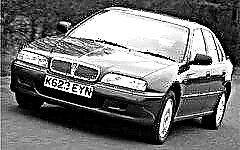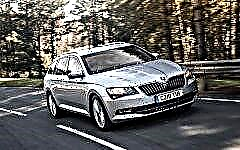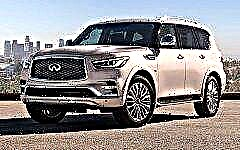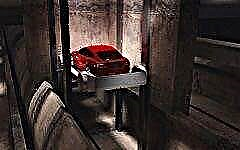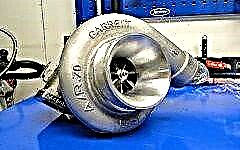
Today it is difficult to find a model of a car, in the power line of which there would be no turbocharged engine. And if even 10 years ago 95% of diesel units were equipped with turbines, today every second gasoline engine has a turbocharger system. Turbines increase engine performance up to two times and reduce fuel costs by 30 to 50%.
Like any other unit in a car, a turbine requires systematic inspection and repair. How to diagnose an automobile turbine on your own, what will be offered in a car service, what is the difference in units for gasoline and diesel engines - more on this later in the article.
The device and principle of operation of the autoturbine

The turbocharger belongs to the additional equipment of the engine, it allows to increase the volume of the supplied air into the intake manifold system without changing the volume of the engine cylinders. The turbine is installed at the inlet and outlet pipes.
The turbocharger is started by the pressure of the exhaust gas which is supplied to the rotor. The mechanism spins up, air is forced into the cylinders.
An intercooler or radiator is used to cool the supplied air; the unit is located at the outlet of atmospheric air from the cold turbine scroll. After a portion of the fuel has burned out in the cylinder, the piston throws the exhaust gas into the exhaust manifold, the gas passes through the hot turbine volute, driving the rotor shaft.
The turbine works only on the basis of air movement, and additional components are not required to spin the rotor shaft. The lubrication system for the movable parts of the turbocharger is combined with the engine lubrication system.
Two impellers of the cold and hot volute are interconnected by a common shaft. To optimize rotor performance, the turbine uses a variable geometry mechanism. An actuator or electronic servo drives the geometry ring with the blades installed, changing the area of the exhaust gas passage adjusts the air flow for optimal engine performance.
Variable Turbo Geometry (VNT) is only used on diesel turbines. The mechanism quickly breaks down at high temperatures, which are formed as a result of the combustion of a gasoline mixture.
The Difference Between Diesel and Gasoline Turbines

For each class of internal combustion engines, its own turbine is selected, the amount of boost depends on the power of the engine, the size of the snails and the type of fuel. Structurally, turbochargers for gasoline and diesel engines are the same, but they have a fundamental difference in the material of manufacture.
The temperature at the outlet pipe of a diesel engine rarely exceeds 800 degrees, the average temperature of the spent gasoline sweep is from 1100 degrees. For a gasoline turbine, a heat-resistant and heat-resistant alloy is used, otherwise, under the influence of high temperature, internal parts wear, coking, and breakdown will occur.
Broken impeller blades pose a great danger, which can enter the cylinder block and cause serious engine damage. For this reason, diesel turbochargers are not installed on gasoline engines, even if the engine size and power are the same.
Causes and symptoms of a faulty turbine

Turbochargers are considered quite vulnerable parts of the engine, but a dropped thrust may not always indicate problems with the turbocharger. What signs may indicate that the turbine needs to be checked:
- Grinding, hum, any abnormal sounds in the turbine area after turning on the ignition. The turbine begins to fully operate at a speed of 1300 rpm, but the start of the movement of the impeller of a cold snail begins after the engine is activated at idle speed.
- Engine traction disappears, slow acceleration is felt, traction dips.
- Exhaust gases change color to gray, blue, black. This sign on diesel engines can also indicate that the catalyst has failed.
- Increased oil consumption.
In 80% of cases, the turbine breaks down due to poor quality or simply dirty oil and a clogged air filter, when debris gets into the inlet manifold. 20% of malfunctions are associated with depressurization of the system - as a result, oil leaks, coking of the variable geometry mechanism.
We do diagnostics of automobile turbines on our own

To carry out a complete diagnosis of the turbine, the unit is always dismantled from the car. On many machines, a sufficient number of attachments must be removed before reaching the machine. The work becomes more complicated if it is necessary to check models with two turbines - in this case, the car is installed on a lift.
Rotor balancing should be carried out at the stand, and if the option of garage repair is chosen, it is necessary to purchase original repair kits with correctly centered parts and verified geometry. Diagnostic procedure:
- Disconnect the intercooler intake manifold pipe from the turbocharger housing, assess the quality of the gasket and oil seal. The inside of the tube is ideally dry, with a minimum amount of oil allowed. If there is a large amount of lubricant inside, it is necessary to check the lubrication system in the vehicle.
- Check the integrity of the blades - the impeller must be intact, without wear and tear and broken parts. If there is a significant depletion of the impeller, the assembly changes.
- Check the movement of the shaft in the vertical plane, the permissible value is –0.1 mm, the permissible backlash in the main plane should not exceed 0.1 mm. A well-adjusted shaft does not give any backlash.
- Check the turbine casing, inlet pipes, flanges for mechanical damage, and if the casing defect is small, repair is carried out. Flanges, gaskets, bearings are changed.
How is diagnostics done in the workshop

In a special workshop, the turbine is diagnosed in stages: on the car engine and on the stand. Before starting the inspection, dismantling of adjacent parts from the engine compartment is carried out:
- branch pipes;
- parts of the vehicle exhaust system;
- an exhaust manifold.
The master conducts a visual inspection, which excludes oil leakage, the presence of mechanical damage, checks the serviceability of the wheel, impeller. Diagnostic procedure:
- Shaft backlash is checked.
- The performance of the variable geometry mechanism is checked by the smooth running of the lever rod. If there is a tight move, there are traces of coking, the mechanism is disassembled and cleaned.
- Checking the turbocharger control valve. The part is relieving excess pressure in the turbocharger system. If defects are observed: coking, burn-in, stuck, frozen, the element is changed.
If mechanical damage is found to the blades of a hot volute that receives exhaust gases from the engine, this is the fact that there is significant damage to the engine - for example, piston rings or pistons. If the valve seat is damaged, debris will fall into all cylinders, and the motor will jam at any time. The malfunction is characterized by a strong knock in the motor.
If, after visual inspection, no defects in the turbine are detected, the unit is diagnosed at the stand. Using special equipment, they check:
- Measurement accuracy of the dismantled turbocharger.
- The operation of the turbine at maximum speed, the option of oil leakage, the order of operation of the geometry, the actuator are checked.
- Checking sensors. In one case out of ten, a malfunction in the turbocharger is associated with a failure of the turbine control sensor and incorrect operation of the control solenoid valve.
- Balancing check.
In the workshop, after dismantling the turbine, all internal elements are cleaned in a sandblasting machine, the used parts are replaced with similar ones from the repair kit.
How to extend the life of a turbine

The main factor that will shorten the life of the turbine is dirty oil. In engines with a turbocharging system, it is recommended to change the oil at least every 7-8 thousand kilometers. In order not to reduce the engine thrust, debris from the outside does not enter the turbine; in the intervals between oil changes, the air filter changes 2 times.
To prolong the life of the turbine, it is necessary to systematically change the oil filter and check the operation of the check valve. The quality of the oil plays a decisive role in preventing coking of the moving parts of the turbine. The amount of oil in the internal combustion engine system, like the pressure, must be sufficient. If the turbine is often started from a dry start, overheating of parts and rapid wear are inevitable.
Each driver can independently diagnose the turbine, but not everyone will be able to carry out repairs. Considering that a full-fledged diagnosis is carried out on a disassembled turbocharger, there is a high probability that after dismantling the system and finding a breakdown, the car owner will not be able to install the turbine “as it was”. Therefore, only experienced motorists repair compressors in the garage.

|| list |
- The device and principle of operation of the autoturbine
- The Difference Between Diesel and Gasoline Turbines
- Causes and symptoms of a faulty turbine
- We do diagnostics of automobile turbines on our own
- How is diagnostics done in the workshop
- How to extend the life of a turbine



